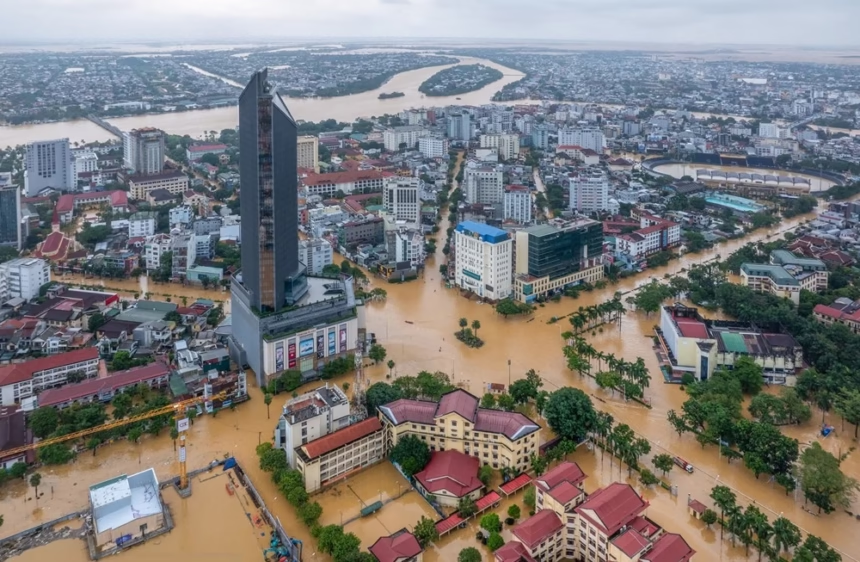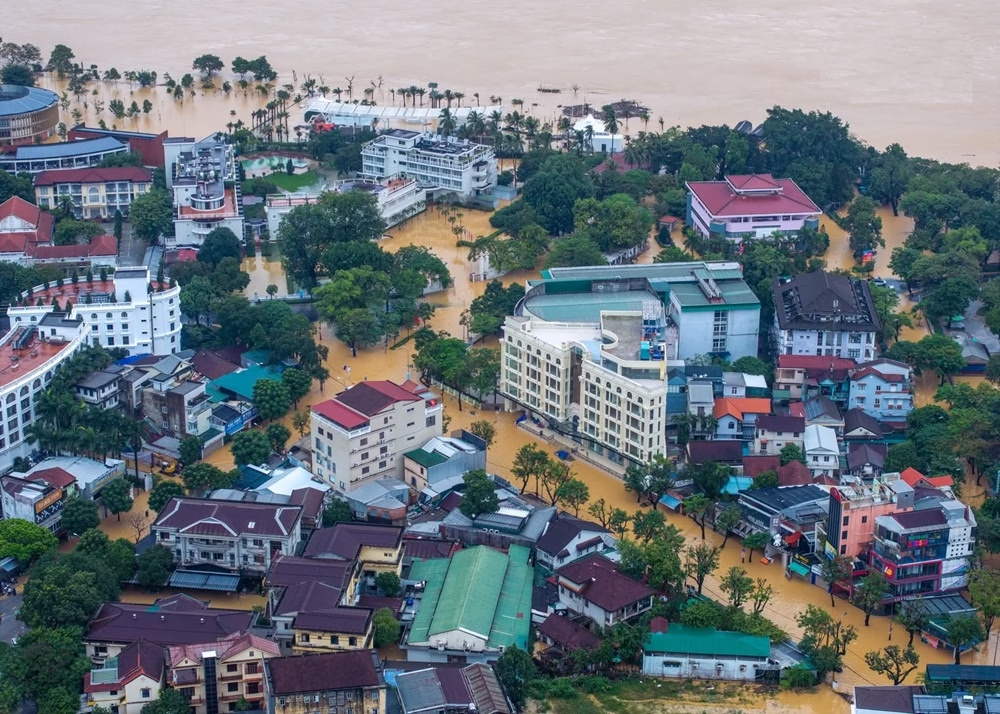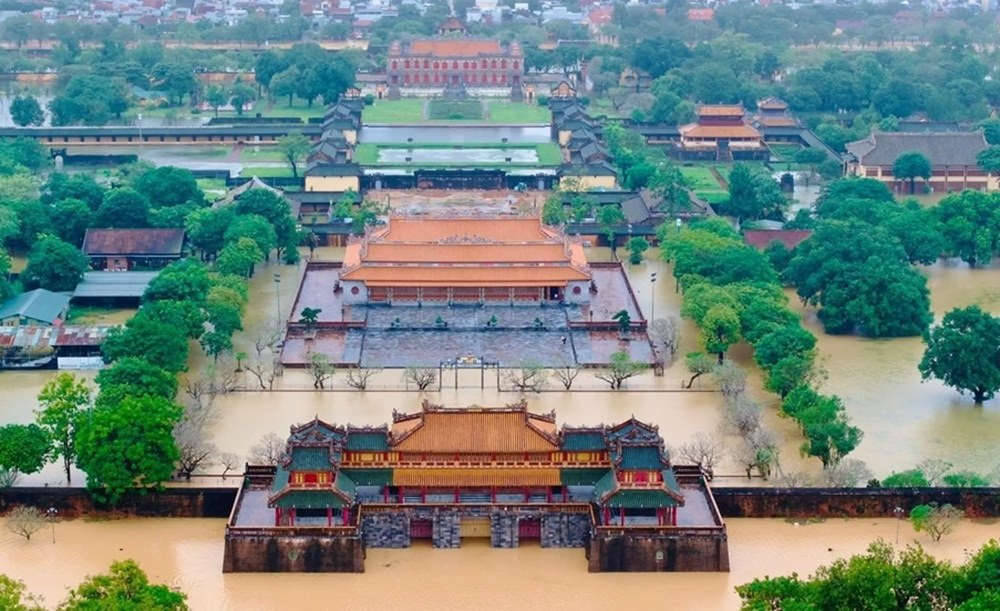HANOI – Central Vietnam’s historic core, usually glowing with lantern light and calm waterways, now sits under floodwater. A week of record rain has swamped provinces across the centre, with at least 13 people dead and 11 missing, according to government figures. Tens of thousands have left their homes. Some areas are starting to dry out, yet the scale of need is growing, and the hit to tourism may last for months.
Tropical Depression Fengshen, combined with water released from upstream dams, set off the disaster. The Perfume River in Hue rose to a level never seen before, about 15 feet above normal, turning parts of the former imperial city into a maze of waterlogged streets.
In Hoi An, only 30 kilometres south, flood levels topped seasonal highs, pushing water to the roofs of wooden shophouses and forcing large boat rescues. Da Nang’s coastal districts suffered breaches in embankments, leaving pockets of the city cut off as drones filmed people stranded on rooftops, surrounded by debris.
Vietnam floods cause heritage at risk
Hue, once the seat of the Nguyen emperors, has taken the worst blow. More than half of its 40 communes remain underwater, with main roads blocked and sections of the Citadel flooded. Authorities say over 120,000 homes across central provinces have been affected, with thousands in Hue alone. Fatalities include drownings and landslides that hit rural families. A five-year-old girl is still unaccounted for after being swept away in a swollen stream on the outskirts.
Hoi An, the 15th-century trading town known for silk shops and evening lanterns, has also been hammered. Floodwater submerged the Japanese Covered Bridge, and traders trudged through sludge to save what stock they could.
One guesthouse owner said tourism pays for everything in the town, and that the loss feels crushing as she cleared debris from her family’s property. Da Nang reported further isolation after landslides, deepening pressure across this popular corridor that attracts millions each year.
The toll rose from nine on Tuesday to 13 by Friday, while teams searched landslide zones in Quang Ngai and Quang Tri. The missing include workers pulled away by strong currents during embankment repairs and children who fell into rivers.
Wider data shows a tough year: the General Statistics Office recorded 187 deaths or disappearances from natural hazards in the first nine months of 2025. This event alone has pushed damages beyond 610 million dollars nationwide.
Evacuations continue at scale, with tens of thousands moved, including about 40,000 tourists in low-lying parts of Hoi An. Schools and temples now shelter families whose homes were torn apart by fast water.
State response, a race against draining floods
Officials have moved quickly. Prime Minister Pham Minh Chinh approved a 350 billion VND, or 13.2 million dollars, relief package for Hue, Quang Tri and Quang Ngai, funding food deliveries, clean water points and urgent repairs. In a televised address, he called for rapid action and directed ministries to focus on older adults, children and other at-risk groups.
Troops from the People’s Army joined rescue teams across the region, using helicopters and rubber boats to reach villages cut off by high water. Police in Quang Ngai trialled drone drops of rice and medicine to isolated households. Vietnam Railways halted north-south services after track washouts, and Da Nang airport scaled back operations, diverting flights where possible.
Health workers warn of disease outbreaks linked to dirty water, including leptospirosis. Teams in protective gear have treated wells and handed out antibiotics. As of Saturday, at least 56 homes were reported destroyed and 147 badly damaged, and local plans include modular housing for those who cannot return.
Aid from abroad has begun to arrive. The U.S. Embassy urged its citizens to follow local advice, and Hanoi is working with ASEAN partners on temporary flood defences and technical help.
Challenges remain. Forecasts point to more rain through mid-November, raising landslide risks in the Annamite Mountains. Rural districts, where about 70 percent of deaths occurred, are the hardest to reach, with some areas still lacking power and mobile coverage.
Tourism stalls, lantern towns go dark
Tourism, worth about 30 billion dollars a year, or 8 percent of GDP, faces a sharp setback. Hue and Hoi An welcomed more than five million visitors in 2024, and their temples, markets and rivers draw travellers from across the world. The floods have paused that momentum.
Hotels shut their doors midweek, and Anantara Hoi An Resort turned lobbies into shelters as thousands of guests were moved to safer ground. Boat trips on the Thu Bon River are cancelled, and night markets sit closed under soaked tarps.
A Hoi An guide said the region lost a month of income in a single night after he ferried visitors to safety in his small boat. Early estimates point to losses of about 50 million dollars, with cancellations up 300 percent on booking sites.
Stories from visitors continue to spread online. A French honeymooner wrote that the couple came seeking magic but fled at dawn by boat, their bags floating past. Travel advisories from the EU and the U.S. now recommend delaying trips, which could thin crowds until Tet in February.
There are signs of recovery efforts. Local groups are promoting higher-ground routes, including visits to Hue’s Thien Mu Pagoda. Businesses and officials are pressing for climate-ready plans, such as raised walkways, early warning phone alerts and pooled insurance. One artisan in Hue summed up the mood by saying floods may come, but the spirit of the people remains steady.
Near the Citadel walls, volunteers pick through mud for lost keepsakes, piecing together fragments of a long history. The water will drain, yet the cultural heart of central Vietnam carries new scars. As crews clear streets under brighter skies, one test stands out: how to rebuild, protect heritage and keep communities safe for the seasons ahead.

















